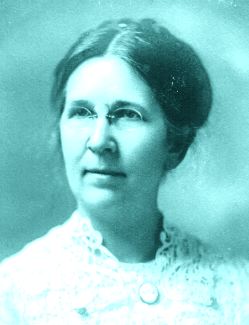Born: Monmouth, Illinois, October 7, 1858
Died: San Diego, California, January 12, 1947
"First Woman Ichthyologist of Any Accomplishments"
In the dark, rocky caves beneath San Diego's Point Loma Peninsula live schools of little, pink, blind fish, six or seven inches long. They were discovered and later described and classified by a young woman named Rosa Smith. The blind goby, Typhologobius californiensis (now Othonops eos) inaugurated her career. According to famed marine biologist Carl L. Hubbs, "Rosa Smith was indeed the first woman ichthyologist of any accomplishments."*
Smith was the last of nine children. Her parents had come from California to Illinois to launch a newspaper, but they returned when their frail, tubercular youngest was advised to seek a warmer climate. Rosa finished her secondary schooling at Point Loma Seminary, taking a lively interest in the natural history of the region. She joined the San Diego Society of Natural History and began, as an amateur, to collect, observe, and identify local species of animals and plants.
In 1879, the noted ichthyologist David Starr Jordan came to San Diego. One of Rosa Smith's daughters wrote that Jordan met Rosa Smith while renting a horse and buggy from her father, but another daughter believed they met at the Society of Natural History. There, the story went, Jordan heard Smith read a paper on a new species of fish (very likely the blind goby), was deeply impressed, and urged her to study with him at Indiana University.
Rosa spent the summer of 1880 on a natural history tour in Europe with Jordan and his students, then attended Indiana University for two years, but was called home owing to illness in her family and did not graduate. Before she left, Jordan introduced her to a young German student of his named Carl H. Eigenmann, who was in the process of obtaining a doctorate in ichthyology.
Back in San Diego, Rosa Smith undertook the formal description and publication of the various species of blind goby and other fish, and she kept up an exchange of papers and correspondence with Carl Eigenmann. Before they married on August 20, 1887, she had published nearly 20 papers on her own. They collaborated first on a study of South American freshwater fishes in the collections at Harvard, and Rosa Eigenmann was the first woman allowed to attend graduate-level classes there.
In 1891, Jordan became chancellor of Stanford University, and Carl Eigenmann was left to head the zoology department at Indiana University. He ultimately became department chair and, later, Dean of the Graduate School. The five Eigenmann children included a disabled daughter and a son who was eventually institutionalized, and the burden of child care fell heavily on Rosa Eigenmann. Nevertheless, she managed to collaborate with her husband on 15 more papers. Eigenmann and Eigenmann were first to describe some 150 species of fish.
When Carl Eigenmann had a stroke in 1927, Rosa returned with him to San Diego, where he died on April 24. She stayed in San Diego with her children but was not scientifically active. Her brief but productive career had been pursued in spite of all obstacles, and she once wrote, "in science as everywhere else in the domain of thought woman should be judged by the same standard as her brother. Her work must not simply be well done for a woman."
* Letter from Carl L. Hubbs to Edward T. James, Editor, Notable American Women, 6 October 1964, in Hubbs Papers, SIO Archives, UCSD, MC5, Box 9, Folder 111.
